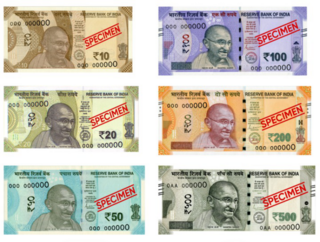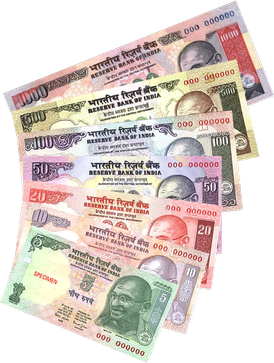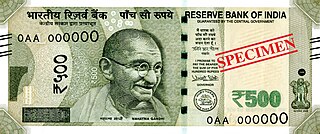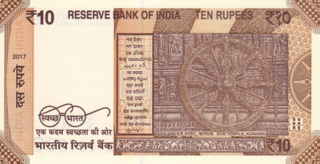
The Reserve Bank of India, abbreviated as RBI, is India's central bank and regulatory body responsible for regulation of the Indian banking system. Owned by the Ministry of Finance, Government of India, it is responsible for the control, issue and maintaining supply of the Indian rupee. It also manages the country's main payment systems and works to promote its economic development. Bharatiya Reserve Bank Note Mudran (BRBNM) is a specialised division of RBI through which it prints and mints Indian currency notes (INR) in two of its currency printing presses located in Mysore and Salboni. The RBI, along with the Indian Banks' Association, established the National Payments Corporation of India to promote and regulate the payment and settlement systems in India. Deposit Insurance and Credit Guarantee Corporation was established by RBI as one of its specialized division for the purpose of providing insurance of deposits and guaranteeing of credit facilities to all Indian banks.

The Indian rupee is the official currency in India. The rupee is subdivided into 100 paise. The issuance of the currency is controlled by the Reserve Bank of India. The Reserve Bank manages currency in India and derives its role in currency management based on the Reserve Bank of India Act, 1934.

The Pakistani rupee is the official currency in the Islamic Republic of Pakistan. The issuance of the currency is controlled by the State Bank of Pakistan. It was officially adopted by the Government of Pakistan in 1949. Earlier the coins and notes were issued and controlled by the Reserve Bank of India until 1949, when it was handed over to the Government and State Bank of Pakistan, by the Government and Reserve Bank of India.

Coins of the Indian rupee (₹) were first minted in 1950. New coins have been produced annually since then and they make up a valuable aspect of the Indian currency system. Today, circulating coins exist in denominations of One Rupee, Two Rupees, Five Rupees, Ten Rupees and Twenty Rupees. All of these are produced by four mints located across India, in Kolkata, Mumbai, Hyderabad, Noida.

The history of the rupee traces back to ancient times in the Indian subcontinent. The mention of rūpya by Pāṇini is seemingly the earliest reference in a text about coins. The term in Indian subcontinent was used for referring to a coin.

The Gandhi Series of banknotes are issued by the Reserve Bank of India (RBI) as the legal tender of Indian rupee. The series is so called because the obverse of the banknotes prominently display the portrait of Mahatma Gandhi. Since its introduction in 1996, this series replaced all Lion Capital Series banknotes issued before 1996. The Reserve Bank of India (RBI) introduced the series in 1996 with ₹10 and ₹500 banknotes.

The Indian 1000-rupee banknote is an obsolete denomination of the Indian rupee. It was first introduced by the Reserve Bank of India in 1938 under British rule and subsequently demonetized in 1946. Post-independence, the denomination was re-introduced in 1954. In January 1978, all high-denomination banknotes of ₹1000, ₹5000, and ₹10000 were demonetized in order to curb unaccounted cash money.

The Indian 500-rupee banknote is a denomination of the Indian rupee. In 1987, the ₹500 note was introduced, followed by the ₹1,000 note in the year. The current ₹500 banknote, in circulation since 10 November 2016, is a part of the Mahatma Gandhi New Series. The previous banknotes of the Mahatma Gandhi Series, in circulation between October 1997 and November 2016, were demonetised on November 8, 2016.

The Indian 100-rupee banknote is a denomination of the Indian rupee. It has been in continuous production since Reserve Bank of India took over the functions of the controller of currency in India in 1935. The present ₹100 banknote in circulation is a part of the Mahatma Gandhi New Series.

The Indian 50-rupee banknote is a denomination of the Indian rupee. The present ₹50 banknote in circulation is a part of the Mahatma Gandhi New Series of banknotes. However, ₹50 banknotes of the previous series will continue to be legal tender.

The Indian 20-rupee banknote is a common denomination of the Indian rupee. The current ₹20 banknote in circulation is a part of the Mahatma Gandhi New Series. The Reserve Bank introduced the ₹20 note in the Mahatma Gandhi New Series in 2019, making it the last denomination to be introduced in the series.

The Indian 10-rupee banknote is a common denomination of the Indian rupee. The ₹10 note was one of the first notes introduced by the Reserve Bank of India as a part of the Mahatma Gandhi Series in 1996. These notes are presently in circulation along with the Mahatma Gandhi New Series which were introduced in January 2018, this is used alongside the 10 rupee coin.

The 2000 rupee note was introduced by the Reserve Bank of India on 8 November 2016. The introduction of this denomination of the Indian rupee was part of the government's demonetization exercise aimed at curbing corruption, black money and counterfeit currency. On the same day, the Indian government announced the demonetization of the existing 500 rupee and 1000 rupee notes. The intention behind demonetization was to invalidate the old notes to disrupt illegal activities and promote a shift towards digital transactions.

On 8 November 2016, the Government of India announced the demonetisation of all ₹500 and ₹1,000 banknotes of the Mahatma Gandhi Series. It also announced the issuance of new ₹500 and ₹2,000 banknotes in exchange for the demonetised banknotes. Prime Minister Narendra Modi said that this decision would curtail the shadow economy, increase cashless transactions and reduce the use of illicit and counterfeit cash to fund illegal activity and terrorism.

The Mahatma Gandhi New Series of banknotes are issued by the Reserve Bank of India (RBI) as the legal tender of the Indian rupee, intended to replace the Mahatma Gandhi Series of banknotes. Announced on 8 November 2016, it followed the demonetisation of ₹500 and ₹1000 banknotes of the original Mahatma Gandhi Series. Similar to the preceding series of banknotes, the obverse of the Mahatma Gandhi New Series banknotes also prominently displays the portrait of Mahatma Gandhi. The logo of Swachh Bharat Abhiyan is also printed on the back of the banknotes of this series.

The Indian 10-rupee coin is a denomination of the Indian rupee. The ₹10 coin is the second highest-denomination coin minted in India since its introduction in 2005. The present ₹10 coin in circulation is from the 2019 design. However, the previous ₹10 coins minted before 2019 are also legal tender in India. All ₹10 coins containing with and without the rupee currency sign are legal tender, as stated by the Reserve Bank of India. Along with the standard designs, there are 4 different designs for this denomination and this is used alongside the 10 rupee banknote.

The High Denomination Bank Notes (Demonetisation) Act, 1978 was an act of the Indian Parliament that demonetized the high-denomination banknotes of ₹1000, ₹5000, and ₹10000. It was first introduced as the High Denomination Bank Notes (Demonetisation) Ordinance, 1978, by the then President of India Neelam Sanjiva Reddy. The then Prime Minister of India, Morarji Desai of Janata Party, and Finance Minister Hirubhai M. Patel were considered key architects of the policy, while RBI Governor I. G. Patel was opposed to it.

The Indian 1-rupee note (₹1) is made up of hundred 100 paise as ₹1 = 100 paise. Currently, it is the smallest Indian banknote in circulation and the only one being issued by the Government of India, as all other banknotes in circulation are issued by the Reserve Bank of India. As a result, the one rupee note is the only note bearing the signature of the Finance Secretary and not the Governor of the RBI. Predominantly pinkish green paper is used during printing.

The Indian 5-rupee note is the second smallest Indian note in circulation. The Reserve Bank of India introduced the 5 rupee banknote as part of the Mahatma Gandhi Series in 1996. The printing of notes in the denominations of ₹5, however, has been discontinued as these denominations have been coinised but still these notes are valid legal tender in India.

The Lion Capital Series were a series of currency notes issued after India declared its independence from Great Britain and used until the Reserve Bank of India (RBI) introduced the Mahatma Gandhi Series in 1996 with banknotes in denominations of 10 and 500 rupees, and were designed with the image of the Lion Capital of Ashoka, the National Emblem which replaced the George VI banknote series. The first banknotes printed after India achieved its independence was a 1-rupee note.





















